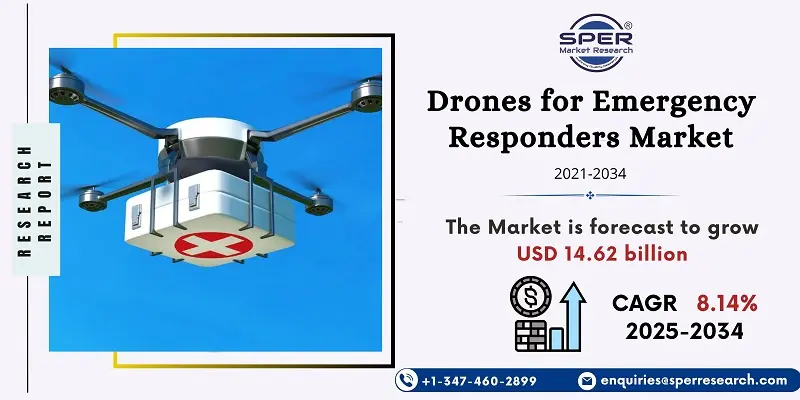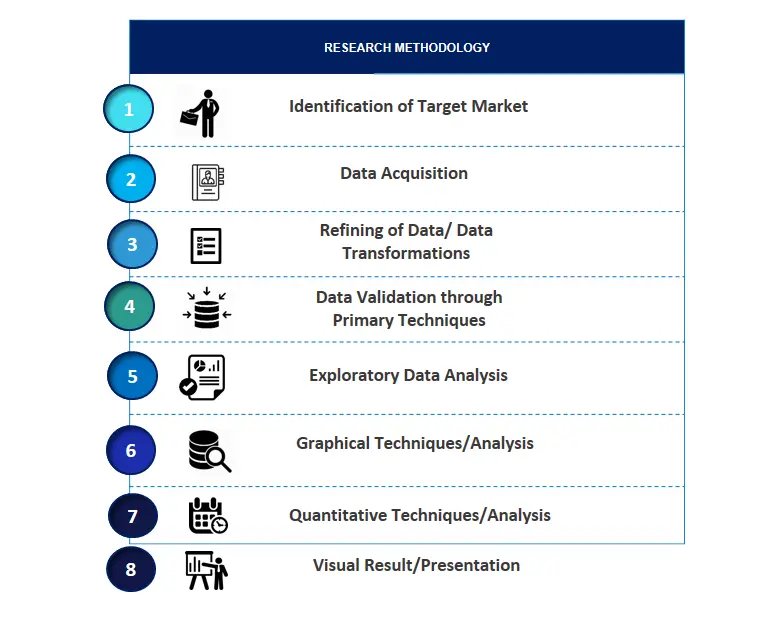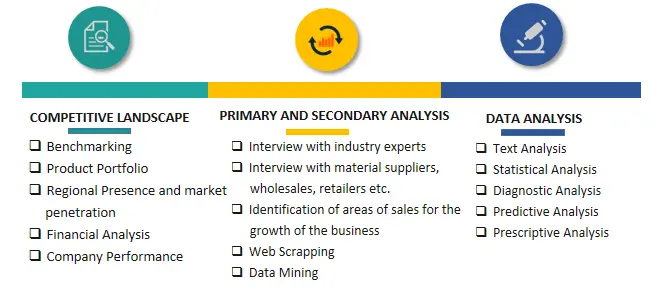
Drones for Emergency Responders Market Growth, Trends, Size, Revenue, Future Outlook
Drones for Emergency Responders Market Growth, Size, Trends Analysis - By Drone Type, By Application, By Level of Autonomy, By End User - Regional Outlook, Competitive Strategies and Segment Forecast to 2034
| Published: Feb-2025 | Report ID: AERO2503 | Pages: 1 - 228 | Formats*: |
| Category : Aerospace and Defence | |||


- In May 2024, During SOF Week, Teledyne FLIR presented the rogue 1 loitering munition system. The business's public and safety portfolio comprises this cutting-edge drone, which adds to its Drones First Response (DFR) division for efficient and quick response to emergencies.
- In April 2024, Draganfly's Commander 3XL drones, which are meant for home hospital deliveries and emergencies, are equipped with ParaZero safety technology. Commander 3XL is ideally suited for dangerous missions that call for the safe and effective deployment of drones in hazardous locations because of this integration, which additionally makes it possible to conduct beyond-visual line of sight (BVLOS) operations and increases safety for pedestrians in densely populated regions.
| Report Metric | Details |
| Market size available for years | 2021-2034 |
| Base year considered | 2024 |
| Forecast period | 2025-2034 |
| Segments covered | By Drone Type, By Application, By Level of Autonomy, By End User. |
| Regions covered | North America, Latin America, Asia-Pacific, Europe, and Middle East & Africa. |
| Companies Covered | Airbotics, Autel Robotics, DJI, Draganfly, Inc., Elistair, Flyability, JOURAV, Parrot Drone SAS, Skydio, Inc., Teledyne FLIR LLC, Yuneec.org. and Others. |
- Global Drones For Emergency Responders Market Size (FY’2021-FY’2034)
- Overview of Global Drones For Emergency Responders Market
- Segmentation of Global Drones For Emergency Responders Market By Drone Type (Fixed-wing drones, Vertical take-off and loading (VTOL) drones, Multirotor drones)
- Segmentation of Global Drones For Emergency Responders Market By Application (Search and Rescue, Disaster Management and Relief, Medical Supply Delivery, Surveillance and Monitoring, Firefighting Assistance)
- Segmentation of Global Drones For Emergency Responders Market By Level of Autonomy (fully autonomous drones, Semi-autonomous drones, remotely piloted drones)
- Segmentation of Global Drones For Emergency Responders Market By End User (Government and Defense, Healthcare and Medical Organizations, Private Sector / Non-Governmental Organizations (NGOs))
- Statistical Snap of Global Drones For Emergency Responders Market
- Expansion Analysis of Global Drones For Emergency Responders Market
- Problems and Obstacles in Global Drones For Emergency Responders Market
- Competitive Landscape in the Global Drones For Emergency Responders Market
- Details on Current Investment in Global Drones For Emergency Responders Market
- Competitive Analysis of Global Drones For Emergency Responders Market
- Prominent Players in the Global Drones For Emergency Responders Market
- SWOT Analysis of Global Drones For Emergency Responders Market
- Global Drones For Emergency Responders Market Future Outlook and Projections (FY’2025-FY’2034)
- Recommendations from Analyst
1.1. Scope of the report1.2. Market segment analysis
2.1. Research data source
2.1.1. Secondary Data2.1.2. Primary Data2.1.3. SPERs internal database2.1.4. Premium insight from KOLs
2.2. Market size estimation
2.2.1. Top-down and Bottom-up approach
2.3. Data triangulation
4.1. Driver, Restraint, Opportunity and Challenges analysis
4.1.1. Drivers4.1.2. Restraints4.1.3. Opportunities4.1.4. Challenges
5.1. SWOT Analysis
5.1.1. Strengths5.1.2. Weaknesses5.1.3. Opportunities5.1.4. Threats
5.2. PESTEL Analysis
5.2.1. Political Landscape5.2.2. Economic Landscape5.2.3. Social Landscape5.2.4. Technological Landscape5.2.5. Environmental Landscape5.2.6. Legal Landscape
5.3. PORTERs Five Forces
5.3.1. Bargaining power of suppliers5.3.2. Bargaining power of buyers5.3.3. Threat of Substitute5.3.4. Threat of new entrant5.3.5. Competitive rivalry
5.4. Heat Map Analysis
6.1. Global Drones For Emergency Responders Market Manufacturing Base Distribution, Sales Area, Product Type6.2. Mergers & Acquisitions, Partnerships, Product Launch, and Collaboration in Global Drones For Emergency Responders Market
7.1. Fixed-wing drones7.2. Vertical take-off and loading (VTOL) drones7.3. Multirotor drones
8.1. Search and Rescue8.2. Disaster Management and Relief8.3. Medical Supply Delivery8.4. Surveillance and Monitoring8.5. Firefighting Assistance
9.1. Fully autonomous drones9.2. Semi-autonomous drones9.3. Remotely piloted drones
10.1. Government and Defense10.2. Healthcare and Medical Organizations10.3. Private Sector / Non-Governmental Organizations (NGOs)
11.1. Global Drones For Emergency Responders Market Size and Market Share
12.1. Asia-Pacific
12.1.1. Australia12.1.2. China12.1.3. India12.1.4. Japan12.1.5. South Korea12.1.6. Rest of Asia-Pacific
12.2. Europe
12.2.1. France12.2.2. Germany12.2.3. Italy12.2.4. Spain12.2.5. United Kingdom12.2.6. Rest of Europe
12.3. Middle East and Africa
12.3.1. Kingdom of Saudi Arabia12.3.2. United Arab Emirates12.3.3. Qatar12.3.4. South Africa12.3.5. Egypt12.3.6. Morocco12.3.7. Nigeria12.3.8. Rest of Middle-East and Africa
12.4. North America
12.4.1. Canada12.4.2. Mexico12.4.3. United States
12.5. Latin America
12.5.1. Argentina12.5.2. Brazil12.5.3. Rest of Latin America
13.1. Airbotics
13.1.1. Company details13.1.2. Financial outlook13.1.3. Product summary
13.1.4. Recent developments
13.2. Autel Robotics
13.2.1. Company details13.2.2. Financial outlook13.2.3. Product summary13.2.4. Recent developments
13.3. DJI
13.3.1. Company details13.3.2. Financial outlook13.3.3. Product summary13.3.4. Recent developments
13.4. Draganfly, Inc.
13.4.1. Company details13.4.2. Financial outlook13.4.3. Product summary13.4.4. Recent developments
13.5. Elistair
13.5.1. Company details13.5.2. Financial outlook13.5.3. Product summary13.5.4. Recent developments
13.6. Flyability
13.6.1. Company details13.6.2. Financial outlook13.6.3. Product summary13.6.4. Recent developments
13.7. JOURAV
13.7.1. Company details13.7.2. Financial outlook13.7.3. Product summary13.7.4. Recent developments
13.8. Parrot Drone SAS
13.8.1. Company details13.8.2. Financial outlook13.8.3. Product summary13.8.4. Recent developments
13.9. Skydio, Inc.
13.9.1. Company details13.9.2. Financial outlook13.9.3. Product summary13.9.4. Recent developments
13.10. Teledyne FLIR LLC
13.10.1. Company details13.10.2. Financial outlook13.10.3. Product summary13.10.4. Recent developments
13.11. Others
SPER Market Research’s methodology uses great emphasis on primary research to ensure that the market intelligence insights are up to date, reliable and accurate. Primary interviews are done with players involved in each phase of a supply chain to analyze the market forecasting. The secondary research method is used to help you fully understand how the future markets and the spending patterns look likes.
The report is based on in-depth qualitative and quantitative analysis of the Product Market. The quantitative analysis involves the application of various projection and sampling techniques. The qualitative analysis involves primary interviews, surveys, and vendor briefings. The data gathered as a result of these processes are validated through experts opinion. Our research methodology entails an ideal mixture of primary and secondary initiatives.



Frequently Asked Questions About This Report
PLACE AN ORDER
Year End Discount
Sample Report
Pre-Purchase Inquiry
NEED CUSTOMIZATION?
Request CustomizationCALL OR EMAIL US
100% Secure Payment






Related Reports
Our Global Clients
Our data-driven insights have influenced the strategy of 200+ reputed companies across the globe.




















